- Home
- Projects & Programs
- Olive B. McLin Community History
- Original Olive B. McLin Community History Project
- Resources
- For Educators
- Scholars / Research
- The Library
- Black history comes to life online
- Bus to Destiny
- Trunk of Hope
- Meet The Graysons
- St. Petersburg and the Florida Dream
- To Be Black and to Live in St. Pete
- People of St. Pete
- Chris Read – Local Writer
- Earl Spinks – Chef & Humanitarian
- Jalessa Blacksheer – Activist & Community Leader
- James B. Sanderlin – Judge
- Thank you Students & Volunteers!
- Partners
St. Petersburg and the Florida Dream
Excerpts from St. Petersburg and the Florida Dream, 1888-1950 by Ray Arsenault.
“While Florida’s political leaders were squabbling over railroad bonds and the implications of black citizenship, and while marauding Klansmen were trying to break the will of Scalawags and Carpetbaggers, the pioneers of lower Pinellas were preoccupied with the problems of survival and subsistence.”

Civil war veterans at Greenwood Cemetery, St. Petersburg, FL
The lower Pinellas frontier had no slaves to emancipate and no “fire-eater” politics to raise its ire, but the Civil War came to the area just the same. Although the peninsula was never a major theater of military operations, it did play an indirect role in the Union’s campaign to blockade Florida’s Gulf coast, which was a potentially important source of salt and beef for the Confederate army. Beginning in the fall of 1861, a small fleet of Union blockaders was stationed at Egmont Key, at the entrance to Tampa Bay. The port of Tampa, like most of Florida, was rabidly pro-Confederate, and the blockaders were given the almost impossible task of sailing off the bay. Egmont Key also served as a refuge for the local Unionist minority, which included James Hay, who fled to their land at the beginning of the war, after selling his Clam Bayou homestead to William Coons for twenty-five dollars and a silver watch. For a time some Unionists tried to remain on the mainland, but sooner or later they were either killed or driven out by the local confederate homeguard.

In one such incident, a well-known Unionist, Scott Whitehurst, was shot and killed in an ambush near Pinellas Point. Rightly or wrongly, the Union commander at Egmont key blamed the murder on Abel Miranda and vowed to bring him to justice. Miranda claimed that Whitehurst was a cattle thief who was supplying the Yankees at Egmont Key with stolen Rebel beef, but the commander was unmoved. In the end, Miranda avoided capture, but in February 1862, a naval raiding partly burned and looted his entire estate. According to John Bethel, who watched in horror from a nearby Indian mound, the Union raiders not only torched Miranda’s home and destroyed his orange grove, but also killed or maimed most of his livestock.
The entire experience only deepened Miranda’s commitment to the Confederate cause. After removing his family to Tampa, which remained in Confederate hands until 1864, he extracted a heavy toll of revenge from the local Union forces, primarily as a blockade runner. Following the surrender at Appomattox, Miranda returned to the Pinellas Peninsula, but he never rebuilt his fish ranch at Big Bayou. Instead, he moved two miles inland, where, he claimed, no Yankee gunboat could ever bother him again. Unrepentant and unreconstructed, he lived on the peninsula until his death in 1900.
 At the end of the Civil War, the only settlers still living on the lower Pinellas Peninsula were William Coons, the enterprising fisherman who had purchased James Hay’s Clam Bayou property in 1861, and his wife. Abel and Eliza Miranda returned to the peninsula in early 1866, followed by John and Sarah Bethel in 1867; and a year later they were joined by a handful of new settlers, including Sarah Bethel’s uncle, Vincent Leonardi. But, even with this trickle of immigration, the area remained a semideserted backwater, a half-forgotten frontier that played no significant role in the drama of Reconstruction. While Florida’s political leaders were squabbling over railroad bonds and the implications of black citizenship, and while marauding Klansmen were trying to break the will of Scalawags and Carpetbaggers, the pioneers of lower Pinellas were preoccupied with the problems of survival and subsistence.
At the end of the Civil War, the only settlers still living on the lower Pinellas Peninsula were William Coons, the enterprising fisherman who had purchased James Hay’s Clam Bayou property in 1861, and his wife. Abel and Eliza Miranda returned to the peninsula in early 1866, followed by John and Sarah Bethel in 1867; and a year later they were joined by a handful of new settlers, including Sarah Bethel’s uncle, Vincent Leonardi. But, even with this trickle of immigration, the area remained a semideserted backwater, a half-forgotten frontier that played no significant role in the drama of Reconstruction. While Florida’s political leaders were squabbling over railroad bonds and the implications of black citizenship, and while marauding Klansmen were trying to break the will of Scalawags and Carpetbaggers, the pioneers of lower Pinellas were preoccupied with the problems of survival and subsistence.
“To the dismay of the state’s seventy thousand freedmen, Radical Reconstruction in Florida was never very radical.”
Of course, very few Floridians actually experienced the “Black Reconstruction” that later dominated the mythology of the New South. To the dismay of the state’s seventy thousand freedmen, Radical Reconstruction in Florida was never very radical. Although Florida’s Reconstruction lasted for twelve years, far longer than in most areas of the South, the state’s ruling coalition of white Republicans presided over a conservative program of limited social change and racial adjustment. When the era was finally brought to a close by the infamous Compromise of 1877 – the backroom deal that put Rutherford B. Hayes in the White House in exchange for a formal end to the Reconstruction experiment – the freedmen of Florida were left with little but unfulfilled dreams and broken promises. While they generally retained the right to vote, Florida blacks were seldom able to acquire their own land, or to sidestep the social and educational restrictions of a white supremacist society.
One of the rare exceptions to this bleak reality was John Donaldson, the first black man to settle on the lower Pinellas Peninsula after the war. An ex-slave who had lived in Alabama, Donaldson migrated to the area in 1868 as an employee of Louis Bell, Jr., a white homesteader originally from the Florida panhandle. The Bell household also included Anna Germain, a mulatto housekeeper who later became John Donaldson’s wife and the mother of his eleven children. The Donaldsons lived and worked with the Bells for several years, but they eventually struck out on their own, purchasing a forty-acre farm located one mile northwest of Lake Maggiore (then known as Salt Lake). Although illiterate, John Donaldson was a man of many talents and won the grudging admiration of almost everyone who knew him.
Working as a truck farmer, drayman, timber cutter, and general jack-of-all-trades, he exercised considerable independence and earned a comfortable living for his large family. Writing in 1914, John Bethel remembered Donaldson as “a man universally respected and one who really kept pace with his white neighbors.” Donaldson’s success can be attributed, in part, to his own resourcefulness. But he also benefited from the physical isolation and racial homogeneity that characterized the Pinellas frontier: out on the fringes of settlement there was very little organized social life, and thus little reason for whites to be overly concerned with the dictates of caste and class – particularly when the local black community consisted of a single family. The tolerance and respect accorded John Donaldson would not be extended to later black settlers, no matter how talented or resourceful they were.

Left: The Pinellas Village Post Office, circa 1900, with Sarah Bethell on the porch. Right: John Bethell, longtime Post Master of the Pinellas Post Office. – credit Florida Public Archaeology Network
During the early twentieth century, the white south was totally committed to the twin concepts of white supremacy and racial segregation. In St. Petersburg, as in other southern cities, interaction between blacks and whites was ruthlessly and systematically controlled by a combination of custom and law known as “the color line” or “Jim Crow.”
Whites who questioned the Jim Crow system were excluded from polite society, and blacks who openly challenged the system were often subjected to physical violence or even death.
Although St. Petersburg was not a classic Southern city, its racial mores were generally consistent with the vaunted Southern way of life. By the beginning of World War I, most local whites considered segregation to be immutable and could not imagine a properly ordered society without strictly defined racial barriers. Yet, despite this depth of feeling, the primacy of Jim Crow was a relatively recent phenomenon.

During the frontier era following the Civil War, the dictates of race and racism had little effect on local life. For two decades, from 1868 to 1887, the local black community consisted of a single family. John and Anna Donaldson, the ex-slaves who migrated to the area with Louis Bell, Jr., at the beginning of Reconstruction, lived uneventfully among their white neighbors. The Donaldsons eventually became landowners and reportedly earned a good living from their forty-acre farm. They also raised a large family, and during the mid-1880s they even sent several of their children to the Disston City School (also known as Prop College) run by Arthur Norwood, the same Englishman who would later give St. Petersburg its first telephone. According to historian Walter Fuller, who interviewed one of the Donaldson children many years later, no one objected to this token school integration; indeed, “nobody thought a thing about it.” Thus, even though the Donaldsons undoubtedly encountered racial prejudice from time to time, the Pinellas frontier seems to have been a relatively tolerant place.
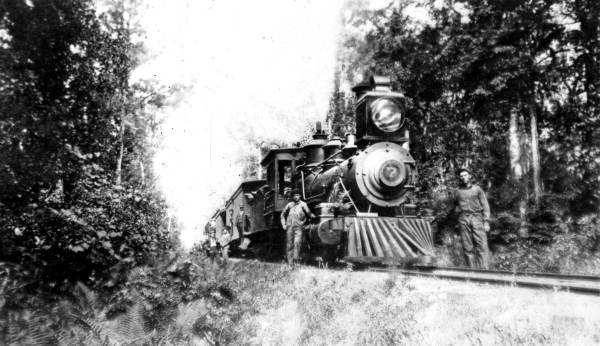
June 8, 1888: First train rolls into terminus ‘St. Petersburg’
This situation began to change in 1888, when the community experienced its first real influx of black settlers. More than a hundred black laborers worked on the final stages of the Orange Belt’s construction, and after the railroad was completed in 1889, a dozen or so stayed on. Joined by their families, these early black pioneers created a small subcommunity along Fourth Avenue South known as Pepper Town. Taking advantage of St. Petersburg’s rapid growth, they found work as day laborers, domestics, artisans, and fishermen.
As the town expanded during the 1890s, additional black settlers drifted in. A few worked on the waterfront as stevedores, and others were recruited by labor agents to work in local hotels. Most of these new black settlers lived in or near a cluster of shacks owned by Leon B. Cooper, a local white merchant. Located on Ninth Street, just south of the railroad tracks, this second black subcommunity was commonly known as Cooper’s Quarters. There were other blacks, usually unmarried men, sprinkled throughout the community, and there was at least one interracial couple living on the edge of town. But the basic pattern of residential segregation was in place well before the turn of the century. Over time, as white residential areas expanded outward from downtown, the black community moved westward. But the boundaries of black settlement remained easily identifiable and nearly inviolate.

Railroad pier in St. Petersburg, 1900
In 1910, blacks accounted for 26.6 percent of St. Petersburg’s 4,127 inhabitants. Predictably, this striking figure was never included in the city’s promotional leaflets. “St. Petersburg does not have a particularly large colored population,” city planner John Nolens insisted in the 1920s, “but like all southern cities it has its colored section.” This carefully calculated understatement may have fooled a few tourists but people who actually lived in St. Petersburg knew that the local black community had a significant and growing presence in the city.
No amount of rhetoric could hide the fact that black labor was a crucial element of the local economy.
Most of the women who washed the clothes and cleaned the houses and most of the men who carried the tourists’ bags, paved the streets, dug the sewer lines, collected the garbage, cleaned the fish, and constructed the city’s houses were black. Without the blood, sweat and tears expended by people of color, St. Petersburg would not have been the up-and-coming city that local whites praised so loudly. Most whites would not have had it any other way. But the existence of an expanding black community presented white supremacists with a dilemma: how could they exploit black labor without creating a biracial community? As slaves and masters, blacks and whites had lived together in “distant intimacy,” but in a free society the simultaneous exploitation and exclusion of an “inferior” race was a much more difficult enterprise.
-
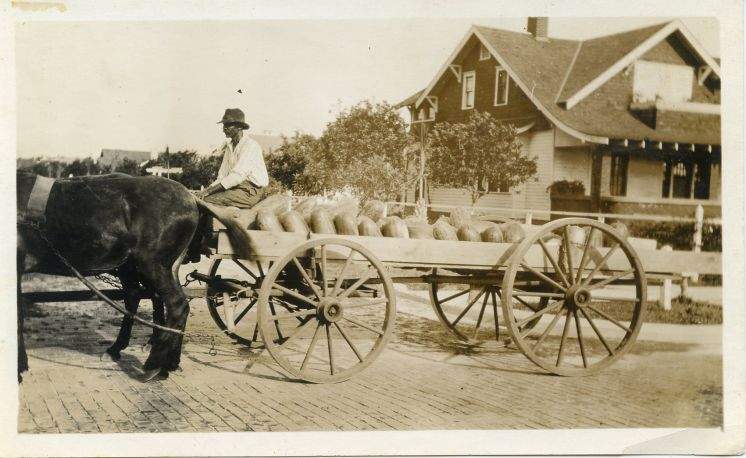
1917, Eaton’s Grove, (now the Euclid St. Paul’s neighborhood) a man hauls fruit. Only three years prior, a lynch mob killed a black man. St. Petersburg Museum of History
-

Eaton’s Grove, January 1920, Courtesy of St. Petersburg Museum of History
Jim Crow in St. Petersburg
In St. Petersburg, as in the rest of the south, the preferred solution to this dilemma was a comprehensive system of Jim Crow laws superimposed on a sanctified code of racial etiquette. Under the Jim Crow regime, blacks were only admitted to the white world at prescribed times for prescribed reasons. Blacks were there when whites wanted them, but otherwise they lived in a separate community. During the day, blacks and whites often mingled in the streets and sometimes worked side by side, but after nightfall blacks were required to return to their own world. This nocturnal separation was mandatory, even for whites; in January 1920, the St. Petersburg police department vowed to arrest “all white men found in the Negro section late at night regardless of their age or social distinction.”
St. Petersburg blacks lived in their own neighborhoods, attended their own churches and schools, swam at their own beaches, drank at their own bars, and were laid to rest in their own graveyards. Without exception, local institutions were separate and unequal. In everything from education to employment, blacks occupied the proverbial bottom rail of St. Petersburg society. Since tax support for black schools was begrudging and woefully inadequate, the black school term was barely half the length of the white term, and black teachers were paid far less than their white counterparts. This institutionalized injustice ensured that many local blacks would remain uneducated and impoverished, but most whites regarded this state of affairs as proper and natural.
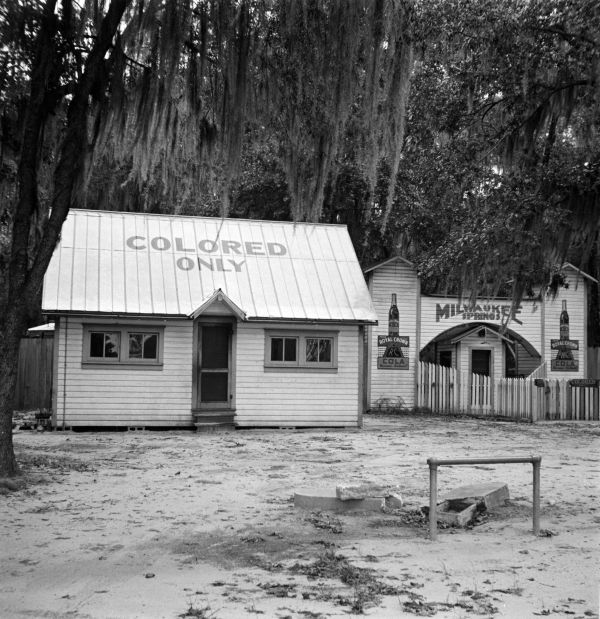
Entrance to Milwaukee Springs, which later served as a health and rec center for black soldiers during WWII.
Since the vast majority of local blacks worked as unskilled or semiskilled laborers, poverty was an ever-present fact of life in black St. Petersburg. Although unemployment was rare, wages were low. Some families had only the barest necessities, and many black homes were little more than tumbledown shacks. However, not all local blacks lived in desperate poverty. Some owned their own homes and businesses, and a few edged their way into the middle class. In 1920, the local black labor force included eighteen teachers, ten grocery store owners, seven barbers, seven tailors, six ministers, four insurance agents, four restaurant owners, two doctors, one dentist, and one hospital superintendent. Collectively, these middle-class occupations accounted for 6.7 percent of the local black working population. Even though many of these individuals had more modest incomes than their titles or occupations would suggest, they represented a nascent black bourgeoisie.
As blacks knew all too well, a failure to live up to racial stereotypes was regarded as an act of betrayal by most whites.
St. Petersburg’s small but growing middle-class black economy was wholly internal and almost invisible to local whites. Blacks with money to spend had to be extremely careful, and the fact that some blacks lived better than many poor whites was rarely bandied about. As blacks knew all too well, a failure to live up to racial stereotypes was regarded as an act of betrayal by most whites. Even blacks who could afford better had no choice but to live in one-story bungalows, since any outward display of conspicuous consumption by a member of the inferior race was considered to be a serious breach of racial etiquette. From the white supremacist perspective, blacks were not supposed to own fancy carriages or automobiles, much less drive them through white neighborhoods.
A Sense of Community
Despite the prevalence of poverty, black St. Petersburg was not a community of despair. Even its poorest citizens were frequently sustained by strong kinship networks and a vital Afro-American fold culture based on religion and communal values. Single-parent households were relatively rare, and local blacks did not have to look outside their community to find inspiring role models or other sources of individual dignity and self-esteem.

Pinellas County, early 1900s
Although almost unknown in the white community, Ira Bryant, the principal of St. Petersburg Industrial High School, and the Rev. James B. Lake, the charismatic pastor of the Bethel Baptist Church, were heroic awe-inspiring figures to local blacks. Moreover, economic hardship and racial condescension did not prevent blacks from developing and taking pride in their own institutions. Several black fraternal organizations met regularly at the Knights of Pythias Hall (there was a separate Knights of Pythias Hall for whites), and, despite being underfunded and understaffed, Mercy Hospital gave the black community a semblance of medical care. Since city parks and public festivals were generally for whites only, blacks also created their own leisure activities, ranging from musical comedy to baseball. In fact, local black baseball teams were often so impressive that they attracted white spectators, who sat in special segregated bleachers. None of this had much impact on the basis power relationships that divided the city into two separate societies, but at least it took some of the sting out of Jim Crow.
Despite its limitations, the black church was the most important antidote to the poison of Jim Crow ideology. More than any other institution, religion dominated the life of the black community. By 1920, local blacks supported seven large congregations and numerous smaller storefront sects. As the cornerstone of the community, evangelical christianity gave the embattled black minority a measure of self-determination and a much needed outlet for emotion and creativity. St. Petersburg’s black churches were comprehensive institutions which provided not only spiritual inspiration and comfort but also social support, cultural enrichment, and entertainment.

Built in 1923, the Bethel African Methodist Episcopal Church is still a pillar of its community nearly 100 years later.
Not everyone in the black community was religious but many blacks spent a major portion of their nonworking hours in church activities. At the Mount Olive Primitive Baptist Church, for example, a typical Sunday included no less than four services. Local blacks could choose from a whirl of activities – church picnics, Sunday school classes, and innumerable sermons delivered by charismatic preachers. As a general rule, black preachers were the community’s most powerful leaders, often serving as both internal power brokers and external liaisons with the white community. Indeed, in the absence of black public officials, preachers frequently were called upon to fulfill political functions.
Black Citizens Challenge Segregation
Despite the local economy’s dependence on black labor, the city’s image-conscious leaders were determined to downplay the importance and the size of the local black community.
In 1930, the same year that the federal census revealed that blacks accounted for 18 percent of the city’s population, the official city directory claimed that st. Petersburg was only 9 percent black. Clearly, in a city that had harbored a substantial black population for decades, the 1930 census figures told city leaders what they already knew but were unwilling to admit. The task of reconciling the city’s self-styled image with demographic reality became even more difficult during the 1930s, when the local black population increased at a faster rate than the white population. Between 1930 and 1940, St. Petersburg’s black population rose from 7,4816 to 11,982, a 61.6 percent increase. During this same period, the local white population increased by only 48 percent.
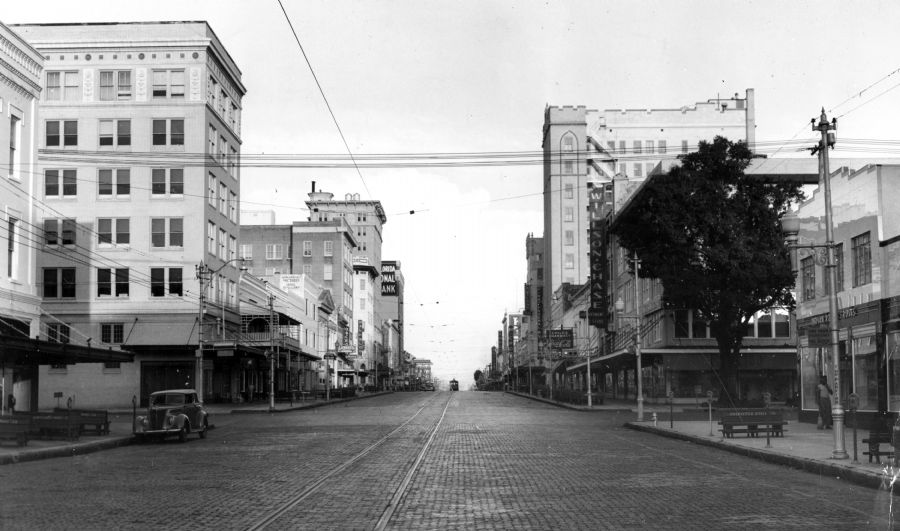
Central Avenue, St. Petersburg in the 1930s
As the black community grew in size and visibility, a number of anxious white leaders called for a stricter and more formalized system of residential segregation. In terms of residential patterns, St. Petersburg was already one of the most segregated cities in the United States. But, according to the new municipal charter adopted in 1931, one of St. Petersburg’s primary civic goals was “to establish and set apart in said city separate residential limits or districts for white and negro residents.” The enforcement of residential segregation would no longer be entrusted to restrictive covenants or racial custom; instead, the city charter empowered city officials “to prohibit any white person from taking up or establishing a place of residence or business within the territorial limits of said city so set apart and established for the residence of negroes, and to prohibit any negro from taking up or establishing a place of residence or business within the territorial limits of said city so set apart and established for the residence of white persons.”
For a variety of reasons – black resistance, preoccupation with economic problems, the fear that the new city charter could not survive a constitutional challenge, and the logistical difficulties inherent in mass relocation – strict enforcement of this segregationist mandate proved to be impractical. But the proponent of the “city within a city” concept did not give up easily. Beginning in the mid-1930s, the city council sponsored an Inter-Racial Relations Committee which sought to improve local race relations by sharply reducing interaction between blacks and whites. Led by its outspoken chairman City Councilman Milledge D. Wever, the committee developed a series of proposals aimed at bringing the city into compliance with the segregationist provisions of the 1931 charter.
In May 1936, at Wever’s request, the city council unanimously approved a resolution that required all blacks to live in an area seventeen blocks long west of Seventeenth Street and south of Sixth Avenue South.
Implementation of the Wever resolution was stymied by insurmountable logistical problems – enforcement would have required the relocation of more than a thousand black families, and he designated area was much to small to accommodate the city’s entire black population. But the mere fact that the city council had endorsed such an extreme measure served notice that the spirit of Jim Crow was still a dominant force in St. Petersburg. The expansion of the black community had provoked a new vigilance among white supremacists, temporarily silencing the moderate white voices that had given the black minority a measure of hope in earlier times.
During the mid and late 1930s, white anxiety about the visibility of the black community seemed to center around the problems of keeping blacks away from the downtown waterfront. The South Mole at the foot of First Avenue South was the only place on the waterfront where blacks were traditionally allowed to swim, but even this one exception became increasingly unacceptable to many white residents.
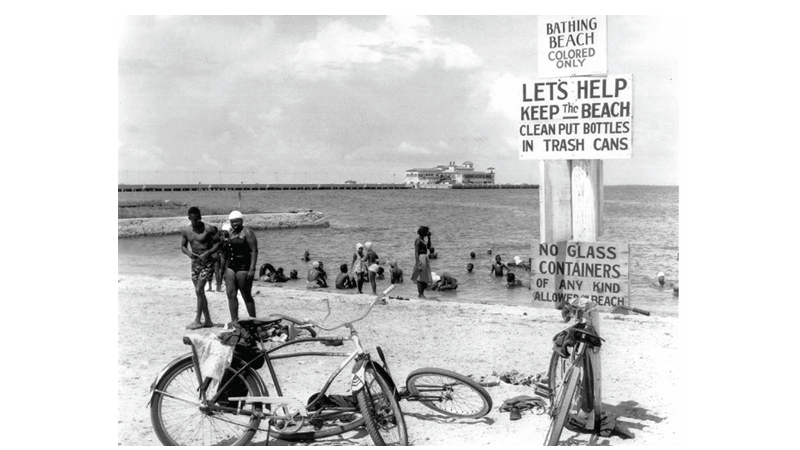
The South Mole
After the city charter of 1931 sanctioned a heightened awareness of racial geography, employment in the white community became the only acceptable reason for a black man or woman to leave he black section of the city. Thus, whenever groups of blacks walked through the downtown area to get to the South Mole, some whites considered their passing through a serious breach of racial etiquette. Their resentment resulted in several ugly incidents, which prompted the city council to search for a black swimming area that was compatible with white supremacist sensibilities.
From 1936 to 1939, the city council’s Inter-Racial Relations Committee spent much of its time on the black beach issue, but none of the committee’s proposed solutions came to fruition. In May 1936, for example, after considering and rejecting several proposed areas – including the north end of Madeira Beach, the east end of Corey Causeway, the southwest corner of Lake Maggiore, and an isolated section on the northwest shore of Papy’s Bayou the city council purchased a small stretch of beach in Pasadena. However, the resulting uproar among the all-white residents of Pasadena and nearby Gulfport forced the council to cancel the plan. City officials later worked out a plan to turn part of Booker Creek into a black swimming hole, but black leaders rejected the idea, insisting that the black community needed access to a saltwater beach.
The refusal to settle for a freshwater swimming hole angered and confused city officials. Such assertiveness would have been unimaginable in the 1910s or the 1920s, and many whites attributed this unwelcome change to the intrusions of the New Deal.
Although, at this point, the black community was incapable of mounting a full-fledged civil rights struggle, the traditional patterns of black passivity and resignation were definitely declining. Led by the local chapter of the National Association for the Advancement of Colored People, the black community exhibited a new determination to defend itself against the worst excesses of racial discrimination. To some extent, the new militance was grounded in subtle changes at the grass-roots level. But it also reflected the emergence of the local black middle class. Despite its limitations, the black middle class had produced a sophisticated group of community leaders. Middle-class blacks did not always understand or empathize with the problems of their working-class neighbors. And some middle-class black power brokers clearly served their own interests at the expense of the black community. But the best of the city’s black leaders were courageous reformers who worked for change while helping their constituents to make the best of a bad situation. On balance, the presence of middle-class black leaders made it much more difficult for whites to ignore the needs and aspirations of the black community. At the very least, white leaders could no longer pretend that the black community was an undifferentiated mass of illiterate domestics and day laborers.
Police Corruption Worsens Disenfranchisement in the Black Community

Unfortunately, and somewhat ironically, the emergence of the black middle class was counterbalanced by a decline in black political power. During the 1930s, black political activity in St. Petersburg was circumscribed by a “white primary” clause in the new city charter. Although a significant number of black voters continued to participate in general elections, the specter of total disfranchisement haunted the black community throughout the decade. As a general rule, city officials were willing to tolerate a limited amount of black suffrage, although some white leaders periodically expressed concern that even a small black vote had the potential to become the balance of power in local politics. This concern surfaced in July 1937, when black participation in a civil service law referendum triggered a storm of protest in the white community.
The referendum and the accompanying controversy over black voting grew out of a bitter struggle between the local civil service board and chief of police Raymond Noel. To the dismay of the civil service board, the city charter of 1931 gave Chief Noel the authority to run the police department almost independently. According to the board, Noel was a power-hungry official who abused his authority. But such criticism only increased Noel’s determination to remain independent from the board. For a time, Chief Noel and A. C. McEachern, the chairman of the civil service board, simply traded threats and insults. But after Noel demoted detective John Siers, one of McEacher’s staunchest allies, to dog catcher, the feud turned into a political donnybrook.
During the fall of 1936, the civil service board formed a special committee to investigate allegations that cronyism and corruption were widespread in the police department.
Some of these allegations concerned minor personnel infractions, but the most serious charges alleged collusion with criminal elements in the black community. According to Chairman McEachern, Chief Noel had allowed “bolita rackets, bootleg joints, and disreputable houses” to operate in the black community with impunity; he had reclassified dangerous convicts as trustees, providing then with unreserved furlough privileges; and on on occasion he had even refused to arrest a black murderer, forcing the city council to turn to the county sheriff for help. Although the case against Noel was hampered by a lack of solid evidence, the investigating committee’s deliberations eventually led to a referendum which gave the electorate the opportunity to repeal the city’s civil service law – a repeal that, in effect, would remove Noel from office.
Noel fought back, but the beleaguered chief found few supporters outside the police department. In the weeks leading up to the referendum, the entire political establishment lined up against him – a situation that ultimately forced him to turn in desperation to the black electorate. Since openly courting the black vote would have been tantamount to political suicide, Noel made every effort to camouflage his political alliance with the black community. But this discretion did not stop the opposition from mounting one of the most virulent race-baiting campaigns in the city’s history. Noel’s alleged violation of racial solidarity provoked a passionate response from white supremacists, and on the eve of the referendum more than two hundred robed and hooded Ku Klux Klansmen descended upon the black community.  The Klan had not marched in St. Petersburg for more than ten years, but the July 1937 march attracted Klan delegations from as far away as Lakeland and Sarasota. During the hour-long, torch-lit procession, the Klansmen warned black onlookers to stay away from the polls. “Our organization is for Americanism,” one Klan leader bellowed, “and using the negro vote for personal gain has no part in our conception of Americanism.” Although no blacks were harmed during the march, this unprecedented show of force carried a clear message of intimidation and potential violence.
The Klan had not marched in St. Petersburg for more than ten years, but the July 1937 march attracted Klan delegations from as far away as Lakeland and Sarasota. During the hour-long, torch-lit procession, the Klansmen warned black onlookers to stay away from the polls. “Our organization is for Americanism,” one Klan leader bellowed, “and using the negro vote for personal gain has no part in our conception of Americanism.” Although no blacks were harmed during the march, this unprecedented show of force carried a clear message of intimidation and potential violence.
An angry Chief Noel encouraged the black community to ignore the Klan’s threats and promised police protection, but most observers predicted that the great majority of registered black voters would stay home on election day. They were wrong. The combination of police power and the black community’s determination to exercise the right to vote resulted in a relatively high black turnout. The size of the black vote surprised almost everyone, including the St. Petersburg Times reporter who covered the election.
“In open defiance of the knights of the Ku Klux Klan,” the reporter marveled, “St. Petersburg negro voters flocked to the polls today….they went in taxicabs, afoot, and reportedly in police cruisers to pile up what will probably be the heaviest negro vote in the history of the city, thereby openly defying the 200 Klansmen who staged an eerie march through the black belt last night as a warning against negroes seeking political power.”
Although chief Noel and his black supporters ended up on the losing side – the civil service law was repealed by a vote of 4,016 to 1,312 – the black electorate’s willingness to stand up to the Klan would be a source of community pride for years to come.
However, the back community paid a heavy price for its alliance with Chief Noel. In October 1937, the new city manager removed Noel from office, replacing him with E. D. “Doc” Vaughn, an experienced policeman who had already served a term as policy chief during the 1920s. Vaughn was known as an uncompromising advocate of white supremacy. Under his leadership, the police department’s activities in the black community became increasingly brutal and repressive. On October 16, less than three weeks after Chief Vaughn assumed his new duties, a shootout between police and a young black laborer, J. C. “Honeybaby” Moses, left two policemen dead. Although Moses was later cornered and shot to death by police, a vengeance-seeking white mob threatened to turn the affair into a full-scale race riot. In the end, Chief Vaughn prevented the mob from mutilating Moses’ body, but his willingness to put the body on public display angered many local blacks.
The Moses case was only the first in a series of incidents that poisoned the relationship between Chief Vaughn’s police department and the black community. Working-class blacks bore the brunt of the police department’s heavy-handed approach to law and order, as periodic “vagrancy sweeps” and “crackdowns” were carried out with ruthless efficiency. But on occasion even middle-class blacks felt the sting of white supremacist law enforcement. For example, in June 1938 a squad of club-swinging police broke up a black teachers’ picnic in the Shore Acres section of northeastern St. Petersburg. Unaware that the city manager had given the teachers verbal permission to hold the picnic, the police upbraided the picnickers for invading a white neighborhood and ordered them to leave. During the ensuing melee, Noah W. Griffin, the principal of Gibbs High School and the president of the local chapter of the NAACP,
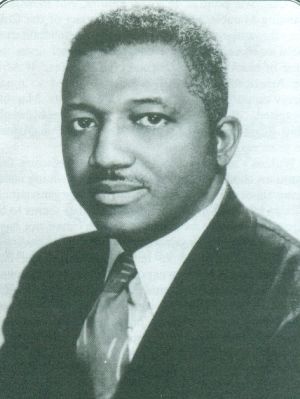
Gibbs High School teacher, Noah W. Griffin 1896-1974. Mr. Griffin went on to become the first director of the Florida West Coast NAACP.
was knocked to the ground, and several other black teachers were roughed up. Many blacks, and even some whites, were outraged by the police overreaction, and in the aftermath of the affair YMCA secretary W. G. Coxhead and several other members of the Inter-Racial Relations Committee urged City Manager Leland to see to it that the police protected the rights of black citizens. The teachers also received strong support from the city’s all-white Ministerial Association. In addition to condemning the “roughness of police officials,” the ministers filed “an urgent request that the city council take immediate steps to provide some beach or bathing pool facilities for 11,000 negro citizens for whose legitimate rights our city has too long neglected to provide.”
The reaction of white moderates to the Shore Acres incident was an encouraging development, but no one in the black community had any illusion that fundamental change was in the offing. For every white moderate who was open to change, there were probably a dozen or more white supremacists determined to keep the black man in his place. At this point, the black community itself exhibited limited capacity for civil rights agitation. Despite the presence of the NAACP and a few black militants, economic vulnerability and the legitimate fear of white retaliation continued to encourage black passivity and resignation. Whatever their true feelings, most black leaders remained extremely reluctant to speak out against racial injustice.
For every white moderate who was open to change, there were probably a dozen or more white supremacists determined to keep the black man in his place.
One of the few exceptions was the Reverend John Wesley Carter, the charismatic pastor of the Bethel Metropolitan Baptist Church. A light-skinned mulatto who had moved to the city from St. Augustine in the early 1930s, Carter never missed an opportunity to remind his parishioners of the moral bankruptcy of racial discrimination. On a few occasions he even managed to deliver his message to the white community. In November 1939, Carter went before the city council to ask for a “new deal” for black St Petersburg. Although he avoided a direct challenge to the sanctity of Jim Crow, he implored the councilmen to treat their black constituents with respect and humane consideration. Under his proposed new deal, city leaders would provide the black community with such needs as decent housing, paved streets, the right to vote, expanded park and recreation facilities, additional roms and beds at Mercy hospital, public restroom facilities, and efficient police protection. Carter also urged the council to hire black policemen, to allow law-abiding black citizens to use the Million Dollar Pier,
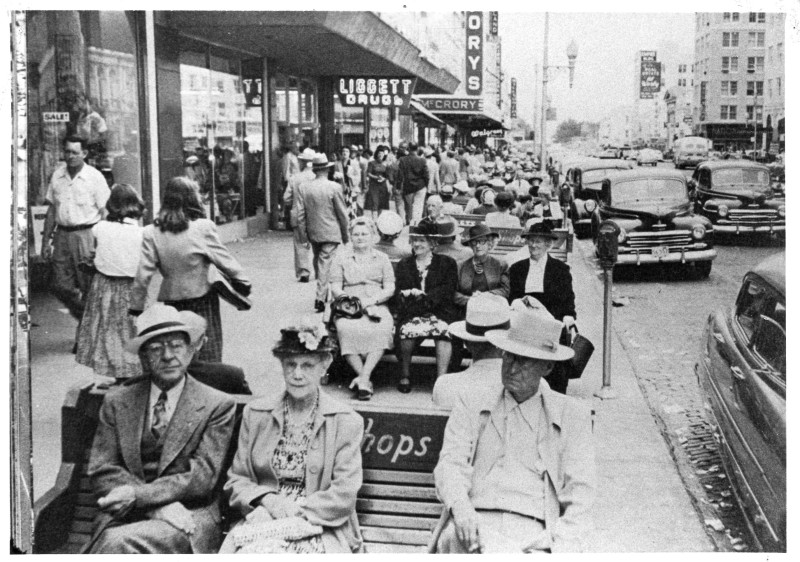
Only white people were allowed to sit on downtown St. Petersburg’s green benches. 1940s
and to enforce the city charter’s exclusion of white residents and businessmen from black neighborhoods. As the last request demonstrates, Carter’s primary goal was equal treatment, not desegregation. But this should not obscure the militance of his stance. In the context of the pre-World War II south, he had gone about as far as a black leader could go.
To its credit, the city council gave Carter a polite hearing, and Mayor Ian Boyer even formed a subcommittee of councilmen to study the minister’s proposal. But civility did not mean acquiescence. In the absence of significant black political and economic power, Carter’s eloquence counted for very little. Despite a growing awareness of black dissatisfaction with the status quo, it would be many years before black St. Petersburg received anything approaching a “new deal.”
The Struggle for Liveable Housing
As late as 1940, 59.2 percent of the city’s black households had no electricity (the comparable figure for white households was 2 percent), and 17.6 percent had no running water (the figure for white households was less than .5 percent).
The emergence of a small cadre of civil rights activists and the ability of black political leaders to fend off disfranchisement were hopeful signs which provided the black community with a psychological lift. But the activities of political and religious leaders did little to ameliorate the underclass status that characterized the lives of most st. Petersburg blacks. During the Great Depression, even more than in earlier decades, the dominant reality in the black community was grinding poverty. As the unemployment rate soared and as financial resources were stretched to the breaking point squalid living conditions became the norm. Overcrowding and substandard housing were increasingly serious problems, and the physical contrast between black and white neighborhoods was more striking than ever. In a city known for stylish homes and beautiful subdivisions, the unpaved streets and unpainted shacks of Methodist Town and other black neighborhoods were inescapable reminders of racial separation and inequality.
Most black families rented their homes from absentee white landlords, many of whom treated both property and tenants with malign neglect. In the words of Karl Grimmer, “a large percentage of the houses were nothing but tumble-down shacks, hardly fit for cattle to live in.” As late as 1940, 59.2 percent of the city’s black households had no electricity (the comparable figure for white households was 2 percent), and 17.6 percent had no running water (the figure for white households was less than .5 percent). Only 1.5 percent of the city’s black families owned their own homes. Most of the homes owned by blacks were modest dwellings located on small lots. In 1940 the average black-owned home was worth less than two thousand dollars and only 4 of the city’s 591 black-owned homes were valued at more than ten thousand dollars. As a WPA investigator described the scene in 1939, there were “a few substantial brick and frame residences” scattered among “the clutter of dilapidated shacks.”
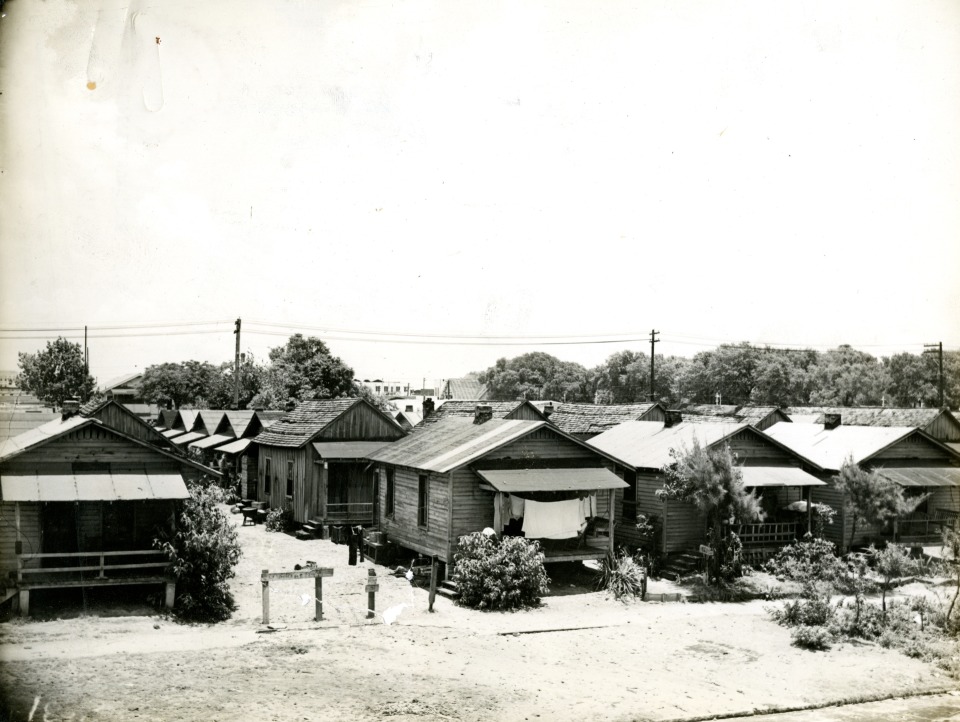
St. Petersburg’s Gas Plant neighborhood in the 1920s
Local reformers both black and white, complained about these slumlike conditions throughout the 1920s and 1930s. But the first serious effort to alleviate the black community’s housing problems did not come until after the passage of the Wagner-Steagall Housing Act in August 1937. Spearheaded by Senator Robert F. Wagner, one of the nation’s leading advocates of slum clearance and urban renewal, the act created the United States Housing Authority (USHA), which was empowered to spend $500 million on the construction of public housing projects. Between 1938 and 1941, approximately 350 such projects were completed, including the highly successful Jordan Park project in St. Petersburg.
Soon after the passage of the Wagner-Steagall Housing Act, local urban renewal advocates began agitating for a USHA appropriation, prompting Mayor Vernon Agee to create a five-member St. Petersburg Housing Authority. Led by local attorney Walter Ramseur, the new city housing authority convinced federal officials that the local black community was in dire need of urban renewal, and in early December 1937 St. Petersburg became one of the first cities in the nation to be offered public housing funds. At first, several members of the city council, including Mayor Agee, were reluctant to accept the USHA’s offer, ostensibly because USHA regulations required the city to contribute 10 percent of the money needed to finance the project. But widespread support for public housing among local business and civic leaders – including the president of the Chamber of Commerce and the head of the downtown Merchants’ Association – soon forced the city council to approve the project. Despite vocal opposition from white slumlords and Negrophobic conservatives, the city council and the USHA eventually agreed upon a plan that would eliminate one unit of slum property for each new unit of public housing. Thus, in August 1938, the USHA transferred nearly a million dollars in funds to the city’s housing authority, which purchased a site of twenty-six acres on the outskirts of the black community. Construction of the Jordan Park project began in april 1939, and took nearly a year to complete. In April 1940 the first tenants moved in, and despite some initial confusion over eligibility requirements, all 242 units were soon occupied.
Pleased with its success, the St. Petersburg Housing Authority approached the city council in the summer of 1940 with a plan to add a second phase to the Jordan Park development. But the housing authority’s negotiations with the city council immediately became entangled in a bitter controversy over utility rates. By July the squabble had evolved into a full scale crisis, with the city council issuing a series of rulings that made it all but impossible to proceed with the proposed second phase. Local slumlords and other opponents of public housing were jubilant, but the city council’s apparent obstructionism ultimately triggered a citywide protest led the League of Women Voters.
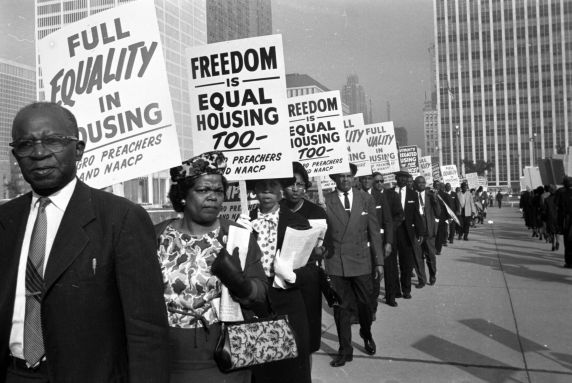
St. Petersburg, 1940, courtesy FL NAACP
Drawing support from a wide variety of civic organizations – including the Chamber of Commerce, the Merchants’ Association, the Board of Realtors, and the Urban League – the League of Women Voters mounted a petition campaign calling for a referendum on the public housing question. After being presented with more than four thousand signatures, an embarrassed city council agreed to submit the question to the electorate in a September 24 referendum.
During the month preceding the referendum, supporters and opponents of public housing traded arguments and insults at a series of public meetings. Although proponents of public housing had the solid backing of the local press, the opposition countered with a spirited grass-roots campaign that attacked public housing as a socialistic challenge to free enterprise and a threat to white supremacy. This attempt to manipulate antiradical and Negrophobic sentiment was not without success, but on election day the supporters of Jordan Park expansion carried the referendum by a surprisingly comfortable margin, 2,731 to 2,081. The housing authority was then able to continue with its plans, and the construction of Jordan Park’s 204-unit second phase was completed in the fall of 1941.
The construction of an all-black public housing project posed no challenge to segregation; indeed, it probably enhanced the notion that “separate but equal” was an achievable and acceptable goal.
The opening of Jordan Park was an important event in the history of St. Petersburg. But for blacks and whites who aspired to live in a racially equalitarian community, it was, at best, a bittersweet victory. The construction of an all-black public housing project posed no challenge to segregation; indeed, it probably enhanced the notion that “separate but equal” was an achievable and acceptable goal. And yet, within the confines of a fundamentally inhumane case system, decent housing did bring an added measure of human dignity and material improvement to men and women who had been systematically deprived of both. Revealing both the potential and the limitations of the city, the resolution of the Jordan Park controversy was symbolic of St. Petersburg’s overall experience during the 1930s. In depression-era St. Petersburg, progress was difficult – but not impossible – to achieve, and the balance sheet at the end of the decade showed mixed results. Despite the efforts of the new Deal and the revival of the tourist trade, economic inequality and racial injustice continued to cast a dark shadow over the Sunshine City. On the other hand, the city and its people had weathered the worst social and economic crisis in American history. Almost incredibly, according to the 1940 federal census, the city’s population had risen to 60,812 – a 50 percent increase since 1930. Growth did not necessarily mean improvement, but the city had clearly entered a new stage of maturity. Like a ship that had sailed through a major storm, St. Petersburg had arrived at mid-passage with a hard-earned sense of its strengths and weaknesses.
Wartime Comes to St. Petersburg
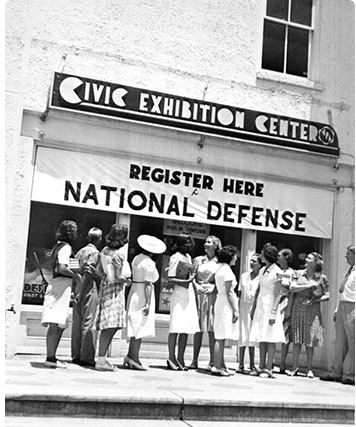
St. Petersburg, FL, 1942
Although it would be difficult to exaggerate the economic and social impact of the wartime military influx, some of the most important developments on the homefront had little or nothing to do with the presence of military personnel. Most obviously, wartime conditions prompted major adjustments in age and gender roles. With so many young men in uniform, retirees, women, teenagers, and even children were called upon to keep city services and private businesses going. At one time or another, nearly everyone shared these burdens, but much of the responsibility for maintaining the homefront fell upon the shoulders of young and middle-aged women. In addition to working as nurses, Red Cross volunteers, teachers, and clerical workers, women frequently found themselves working inn previously all-male occupations. As early as March 1942, the city hired eleven women to work as bus and trolley operators, and by the end of the war women were filling difficult and important positions all over the city. For a time in 1943, local railroads were even hiring women as common laborers. Thus, even though St. Petersburg had no major defense plants, the city was not without its equivalents of “Rosie the Riveter.” Here, as elsewhere, World War II expanded opportunities for women.
The situation was somewhat less favorable for the city’s black minority. But the war years did witness subtle changes in local race relations, as well as some improvement in the economic and social conditions of the black community. The pace of change was still maddeningly slow, and there was no guarantee that change would continue to move in a progressive direction. But the overall trend was encouraging. The decline in racial bigotry was most apparent in the North, but even in Southern cities like St. Petersburg there was a noticeable shift in the racial attitudes of some whites. Although racial prejudice was still rife, Hitler’s promotion of the Aryan as a racial superman tended to discredit racial extremism. Moreover, as the war progressed and as knowledge of the Holocaust spread, the American government’s relentless anti-Nazi propaganda campaign weakened the moral and political position of militant white supremacists. Perhaps most importantly, when set against the backdrop of a war against a racist enemy, the willingness of black soldiers to fight and die for their country led many whites to acknowledge (often grudgingly) the legitimacy of black demands for civic equality.
In St. Petersburg the proportion of men and women in uniform was actually higher in the black community than in the white community.
Nearly two thousand local blacks served in the armed forces during the war, through many whites were unaware of this fact. All of St. Petersburg’s black servicemen were trained at special Jim Crow facilities and later assigned to segregated units. And with the exception of a few Navy stewards, no black servicemen were stationed anywhere in the Tampa bay area. Even so, the black contribution to the war effort was a great source of pride in the black community. It was also a badly needed source of employment for many impoverished black families.
The economic impact of the war on the black St. Petersburg was mixed. On the negative side, the wartime decline in the building trades and the military occupation of the city’s hotels put some black laborers and domestics out of work.
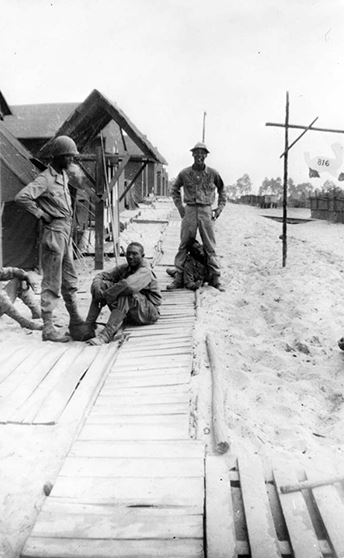
Black soldiers, 1943, Florida
Fortunately, these problems were offset by military employment, rationing, and the general improvement of the local economy. On balance, the average black family was probably slightly better off during wartime than during the late 1930s. In any event, most black families probably regarded these slight economic gains as less important than the general social and political progress that marked the late 1930s and early 1940s.
One of the most important developments of this era, as far as the black community was concerned, was the liberalization of the city’s most powerful newspaper, the St. Petersburg Times. As early as 1937, the Times had spoken out against the white primary and the Ku Klux Klan, but the paper did not make a clear break with its racially conservative past until after the death of William L. Straub in April 1939. With Straub’s death, editorial control of the Times passed to Nelson Poynter, the thirty-five year old son of Paul Poynter, the paper’s longtime publisher. A graduate of Indiana University and Yale University, where he earned a master’s degree in economics, Nelson Poynter was a liberal-minded supporter of the New Deal and an avowed racial moderate. Traditionally, the Times’ coverage of the black community had been limited to crime reports and condescending human interest stories. But under Poynter’s leadership the Times gradually expanded and improved its treatment of black news.
Beginning in October 1939, the Times published a weekly “Negro News Page,” a collection of articles about black church and school activities, sporting and social events, births, deaths, weddings, and other personal news. Written exclusively by black reporters working out of their homes, the Negro News Page generally avoided controversial political and racial issues. But it did break a longstanding taboo against using courtesy titles such as “Mr.” or “Mrs.” or “Dr.” when referring to black men and women. This breach of racial etiquette went almost unnoticed in the white community, largely because few whites knew of the Negro News Page’s existence; the page was only inserted in papers distributed in black neighborhoods. Progress was slower in the regular pages of the Times but the absence of racial epithets and slurs, plus the occasional appearance of feature stories on black celebrities such as Dr. George Washington Carver, signified that the paper was no longer a mirror of racist orthodoxy.
African Americans Make Their Mark on Politics and Government
In December 1941, blacks were allowed to serve on a Pinellas county grand jury for the first time in the county’s history, and soon thereafter J. P. Moses became St. Petersburg’s first black bondsman.
For many local blacks, an even more important development of the late 1930s and early 1940s was the dramatic reversal of the political decline that had threatened the black community in the early years of the Great Depression. St. Petersburg’s black voter registration figures began to edge upward in 1937, the year the Florida legislature repealed the state poll tax. And by the early 1940s, many black leaders were beginning to believe that real political power was in the offing. The greatest impediment to black political power – the white primary system – was still in force and would remain so until after the end of the war. But by 1945 it was clear that the days of the white primary were numbered. In a series of landmark decision, beginning with the Classic case of 1941 ad culminating in Smith v. Allwright in 1944, the United States Supreme Court declared white-only primaries to be unconstitutional. This did not stop local Democratic leaders from announcing, in February 1945, that they had no plans to open their registration rolls to blacks. But this tacit defiance of the Court’s mandate came to an end a year later, swhen Dr. Gilbert Leggett and several other black leaders successfully petitioned the
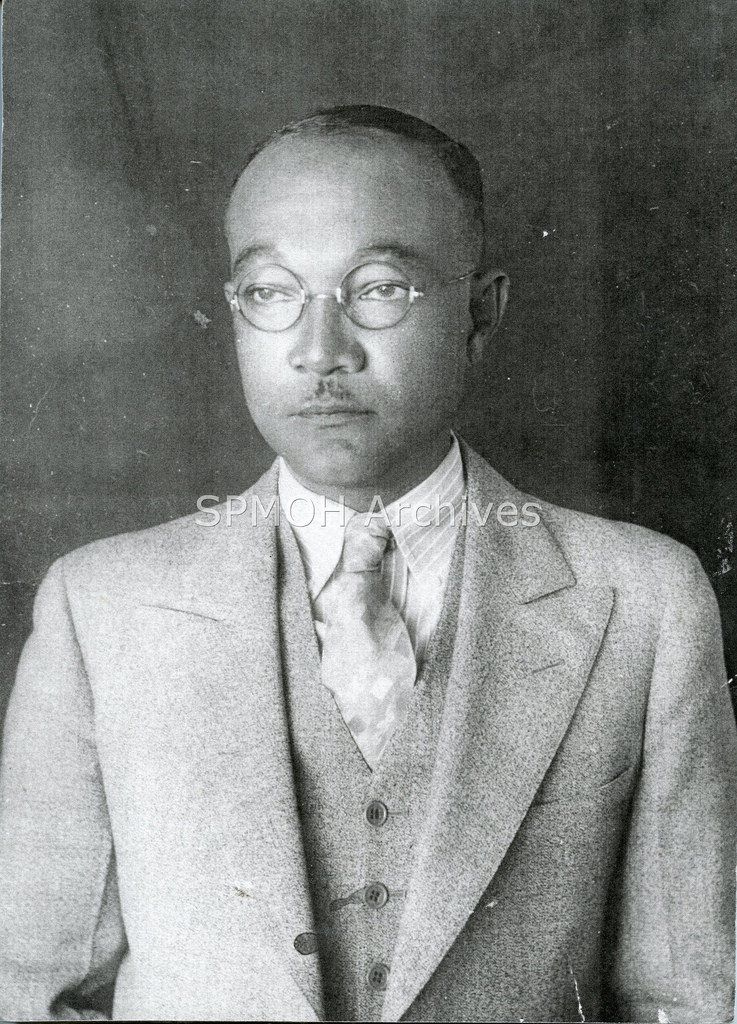
Dr. Gilbert Leggett (St. Petersburg Museum of History)
circuit court to strike down the local white primary system. Hailed as a major victory for local Civil Rights advocates, the 1946 decision led to a sharp increase in black political activity. By the end of the decade, black participation in local Democrat primaries had become commonplace, and the rate of black voter registration in St. Petersburg had risen to 30 percent, one of the highest rates in the South.
There was less progress in the legal justice system, and the repressive nature of the local police remained one of the most threatening aspects of black life. Yet even here there were encouraging signs. In December 1941, blacks were allowed to serve on a Pinellas county grand jury for the first time in the county’s history, and soon thereafter J. P. Moses became St. Petersburg’s first black bondsman. Although token in nature, these developments indicated that there were cracks in the mold, that a closed system was beginning to open, albeit ever so slowly. Unfortunately, real change would not come until 1949, when the police department hired four black patrolmen – the first black policemen in the city’s history. Progressive community leaders, both black and white, had urged the hiring of black policemen for years. But their efforts had been stymied by the reluctance of city officials to challenge the power and authority of Police chief E. D. “Doc” Vaughn. A militant white supremacist whose uncompromisingly harsh attitude toward the black community was a throwback to an earlier, more brutal era, Chief Vaughn was a folksy, self-styled “Florida Cracker” who sometimes seemed out of place in a genteel resort city. He nonetheless received strong support from racial conservatives, both inside and outside of city hall.
During the war, the police department became increasingly repressive in its dealings with the city’s black minority. Beginning in November 1942, when city officials issued a “Work or Jail” edict, the police conducted periodic raids on black bars and pool halls, in an effort to root out “loafers” and “idlers.” Black men who could not prove gainful employment were threatened with imprisonment if they did not cooperate with the police. These raids were stepped up later in the war, especially when there was a shortage of labor. Backed by the city council, which claimed that it would not tolerate loafing during wartime, the police were empowered to act as labor agents for city agencies and other local employers short of labor. City officials generally defended the system in nonracial terms as a necessity of wartime, but the fact that such vagrancy sweeps were limited to black neighborhoods did not go unnoticed in the black community. During the course of the war, local blacks were also angered by several flagrant incidents of police brutality, including the killing of a black male suspect in August 1942, and the savage beating of a black female prisoner in October 1944. The latter case brought a formal reprimand from the city manager, Carleton Sharpe. Sharpe had tangled with Vaughn during an earlier tenure at city hall and had removed him from office in 1934. So it came as no surprise when Sharpe fired Vaughn again in 1945.
Without exception, the city’s black schools were overcrowded and underfunded, and some lacked even the most basic facilities
Sharpe was not the only local official to recognize the need to reform the city government’s relationship with its black constituents. In 1943, the city planning commission issued a surprisingly candid appraisal of the economic and social blight that continued to plague much of the black community. In preparing a new master plan for the city, the commission concluded that the physical condition of the black community constituted a serious impediment to civic progress. Although the planners cited the Jordan Park public housing project as an important step forward, they decried the prevalence of substandard housing in most of the city’s black neighborhoods and acknowledged the stark contrast between black and white schools. Without exception, the city’s black schools were overcrowded and underfunded, and some lacked even the most basic facilities. The critical shortage of space and facilities at Gibbs High School,
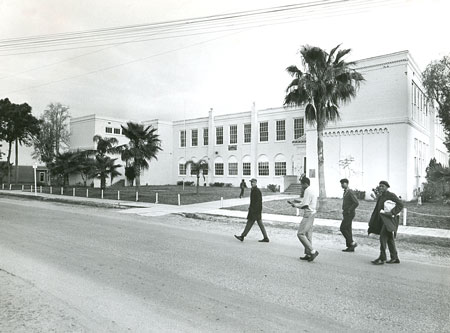
Gibbs High School, opened in 1927 to educate black youth
where 781 students attended a school designed for 350 children, was especially glaring. The report also pointed out the need for additional park and recreation facilities in the black community.
To alleviate these deplorable conditions, the city planners called for a massive infusion of government funds and private capital in the black sections of the city. While black leaders welcomed this unprecedented show of social consciousness, few harbored any illusions that the proposed commitment of funds was compatible with the political realities of a white supremacist society. Despite their good intentions, the planners had failed to identify the primary source of the black community’s problems; nowhere in the report was there even a hint that racial prejudice had contributed to the black population’s plight, or that many of its problems could be partially ameliorated by an abandonment of Jim Crow restrictions.
The National Urban League offered a more probing analysis of black St. Petersburg in 1945. After spending several weeks in the city, a team of Urban League investigators issued a lengthy report that assessed the strengths and weaknesses of the black community and the character of local race relations. The investigators applauded the success of the Jordan Park housing project and noted the emergence of the city’s black middle class, but on the whole they were discouraged by what they saw. Poverty, severe overcrowding, and dilapidated housing were the norm in almost all of the city’s black neighborhoods, and, despite the recommendations issued by the city planning commission in 1943, little or nothing was being done to eradicate these conditions. The city’s black schools – and the white public officials who were responsible for the condition – also came in for sharp criticism. The black school system had no kindergarten classes, no facilities for technical education, and no access to St. Petersburg Junior College, an institution that had become a major source of social mobility in the white community. Black teachers earned far less than their white counterparts (this particular problem would be partially alleviated by a 1946 federal court order), and everything from blackboards to school buses was in short supply.
Poverty, severe overcrowding, and dilapidated housing were the norm in almost all of the city’s black neighborhoods, and, despite the recommendations issued by the city planning commission in 1943, little or nothing was being done to eradicate these conditions.
The Urban League investigators were equally troubled by the poor condition, or in some cases, the absence of other black institutions. In a black population of nearly fifteen thousand, there were only two doctors and no a single lawyer. Mercy Hospital was overcrowded and understaffed. And after six decades the black community still had no public beach, no swimming pool, no library (a black branch of the public library opened in 1946), no blood bank, and no newspaper of its own (though an “underground” paper called The Informer had existed for a brief period during the 1930s). In the area of race relations, the investigators found that residential and social segregation were rigidly enforced, and that blacks and whites had very few opportunities to engage in interracial dialogue or cooperation, the major exception being an informal ministerial network set up by the St. Petersburg Council of Churches in 1940. The report provided numerous examples of the black community’s exclusion and alienation from the mainstream of city life. But the most poignant example was the tradition of fear that kept blacks away from the city’s famous green benches. Although city police no longer prevented blacks from sitting on downtown benches, the investigators discovered that very few black citizens felt secure enough to exercise this new freedom. The wounds of a lifetime would take a long time to heal.
Copyright 2016 nicdark.com